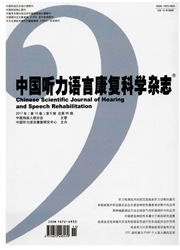

 中文摘要:
中文摘要:
蜗轴缺如属于严重的内耳结构畸形,1998年Antonelli PJ等首次提出“蜗轴发育缺陷对患者听力的影响”;2002年Sennaroglu等通过对内耳畸形形态学及组织胚胎学的比较,提出共同腔畸形和IP-I畸形存在蜗轴缺如;2006年进一步提出“X-连锁遗传性聋伴镫井喷”即“IP-Ⅲ”畸形,存在蜗轴缺如。蜗轴缺如是导致先天性感音神经性聋的重要原因,而对于重度、极重度感音神经性聋患者,人工耳蜗植入是目前疗效最为确切和稳定的治疗方法。本文对有关“蜗轴缺如”患者人工耳蜗植入方法及术后听觉康复效果的研究进行总结,为今后相关课题深入开展奠定基础。
 英文摘要:
英文摘要:
The absence of cochlear modiolus is a serious inner ear malformation. In 1998, Antonelli PJ et al firstly reported the effects of absence of cochlear modiolus on the hearing abilities of patients. Sennaroglu et al pointed out that absence of cochlear modiolus existed in common cavity deformity and IP-I deformity by morphological and embryological study of inner ear malformation in 2002, and proposed that the X-linked congenital hereditary deafness and perilymphatic gusher, namely, incomplete partition III (IP-III), had an absence of cochlear modiolus. The absence of cochlear modiolus is an important reason for congenital sensorineural hearing loss. For the patients with severe and profound sensorineural hearing loss, cochlear implantation is currently the most stable and effective therapy. This article reviews the researches on surgical procedures of cochlear implantation and postoperative rehabilitation outcomes of the patients with absence of cochlear modiolus, thus laying a solid foundation for the future studies.
 同期刊论文项目
同期刊论文项目
 同项目期刊论文
同项目期刊论文
 期刊信息
期刊信息
